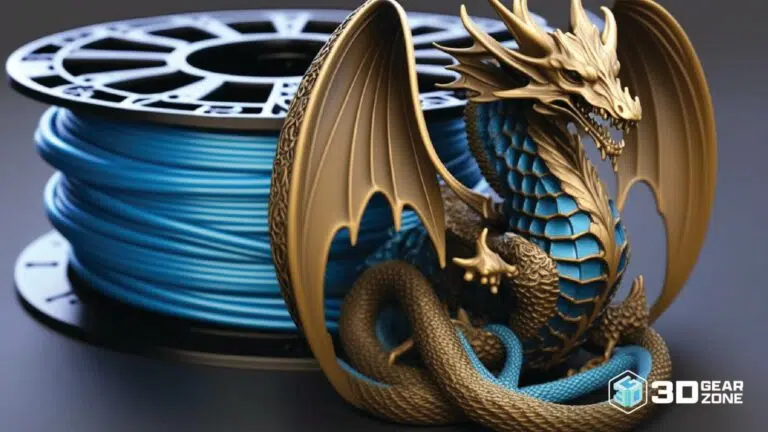3D Printing Guide
Ultimate Guide to Recycling 3D PLA Filament

Scott Gabdullin
Updated on November 15, 2023


Updated on November 15, 2023

Share This Post
If you work with or own a 3D printer, you’ve likely encountered the problem of PLA filament.
The polylactic acid filament is a by-product of 3D printing, and as a plastic, it poses a significant threat to the environment. It can also burden you with plastic debris you can’t quickly dispose of, which will end up costing you time and money.
Although 3D printing promises to support recycling and environmental protection over time by limiting plastic waste, the problem of PLA filament still stands, until now.
New methodologies have made recycling 3D PLA filament easier than ever. You can use this ultimate filament recycler guide for PLA filament. Learn everything there is to know about this quick, easy, and sustainable practice. Let’s get started!
3D printing is a relatively new and sophisticated technology that allows users to create three-dimensional objects from digital files using plastic materials.
3D printers typically use plastic 3D printing materials like Acrylonitrile Butadiene Styrene (ABS), Polylactic Acid (PLA), and more.
PLA filament is a thermoplastic type used when printing 3D objects. It’s called “PLA” because it’s made from polylactic acid. It is ideally a biodegradable plastic derived from renewable resources like cornstarch, sugar cane, and tapioca roots. This makes it a very safe and environmentally-friendly material for 3D printing projects.
For these reasons, many people choose to work with PLA.
PLA filament doesn’t inherently pose a threat to human health. It is primarily made of renewable resources like sugar cane or tapioca beans.
However, it is technically plastic, and since plastic pollution is at an all-time high, it poses a significant environmental threat.
The Organization for Economic Cooperation and Development estimates global plastic pollution has doubled since 2000, reaching nearly 460 million tonnes and contributing to 3.5% of greenhouse gasses.
Millions of marine creatures die yearly because of plastic ingestion or entanglement. While 3D printing is more resource-efficient than other methods, it still promotes the consumption and use of plastics.
Additionally, most filaments, materials leftover from 3D printing, aren’t reused and become plastic waste. This however, can be prevented with the right recycling process.
For this reason, researchers have worked to identify more sustainable practices within 3D printing. This way, 3D printing can still be a resource-efficient technology without posing a threat to the environment.
As in most other fields, there are several ways to minimize the environmental impact of PLA filament and recycle filament.
Most users begin by minimizing their use of this plastic. You can do this in several ways, all of which we’re going to discuss below.
The first step to promoting sustainable practices in using 3D plastics is to minimize your service altogether. If you can avoid using PLA, you should; the tips below offer easy ways to do so.
Most designs with overhangs require supports, and using supports contributes to your overall consumption of PLA. You can minimize using this plastic by eliminating the need for support. Consider building more arch support into your designs.
You can reduce your filaments by adjusting your slicer settings to print with a brim instead of a raft. The brim will limit the use of plastics altogether and provide bed adhesion. This, in turn, will promote the integrity of complex models.
You can also reduce infill by adjusting the percentage metrics on your printer.
If you separate your prints into smaller components, you can avoid having to toss the entire image in the event of a failure. This can save you time and plastic.
Before throwing away any prints or designs, consider how they could be reused. For example, you could use the prints to make a miniature model of something or assemble them into larger pieces.
Now that you’ve saved plastic before even beginning your printing, you can consider printing strategies promoting environmental sustainability. You can minimize your contribution to plastic waste by using only recycled PLA filament.
With so many affordable options, arguing against this strategy is challenging. The recycled filament is often of better quality than new material and is generally the same price.
Some companies allow you to return your 3D printing waste to them and earn credits for recycled filament materials.
Such a service can help you maintain sustainable practices without cutting your budget or spending precious time working with different material companies.
Remember that recycled filament can vary significantly in composition. So it’s essential to ensure that you are purchasing the filament you want and that which will serve you for the longest time possible.
Ask for tips from the manufacturer and assess the tolerance of your recycled filament to prevent jamming and clogging on the hot end of your printer.
You can also finetune your settings according to the above specifications to save even more filament as you work through your print.
In addition to the above methods, consider reusing your best PLA filament. Many people don’t realize they can recycle their plastic parts when 3D printing and the process is relatively easy when done correctly. You’ll need specialized equipment to recycle your PLA filament. These include a filament spool, winder, and PLA filament.
First, you’ll need to cut your plastic parts into small pieces. This can be done with scissors or a knife. Next, feed the pieces of plastic into the filament winder and set the speed for winding. The filament will then be wound onto the spool in a continuous loop.
Once finished, you’ll have a reusable spool of PLA filament. The filament can then be used in your 3D printer, and you can print with it again.
Before you can use your filament, you’ll need to shred it. This prepares your plastic for melting by creating a consistent viscosity and thickness in the plastic. Your input plastic must be uniform to function with your 3D printer.
You can purchase a shredder or make one yourself. It is essential to note that shredders are relatively expensive but can save you money over the long term. This will also produce better results in the overall process.
Alternatively, you can make your shredder. Remember that a manufactured shredder may offer limited functionalities and will take time to complete this DIY process.
You can also extrude your PLA filament if you want to go further. However, this process is more complicated and involves melting the plastic pieces with an electric heating element. You’ll also have to push it through a designated nozzle to create a uniform diameter. The most common diameter measures are 3 mm and 1.75 mm. Your filament must match these dimensions.
You’ll need a premium shredder to achieve the shape and diameter necessary to work your printer.
You can purchase a new extruder from Filabot, Recyclebot, or Noztek Pro. Each extruder offers different capabilities, but they all ultimately recycle your old materials for a new print.
If the above methods are too complex, consider purchasing a complete filament recycler setup that includes everything you need to reuse and recycle your PLA filament.
Complete setups are expensive but can save you time and money in the long run. Each part is carefully tuned, sourced, and ready. Additionally, you won’t need to adjust to accommodate the burden of recycling your filament.
Keep in mind that there are drawbacks to using complete setups. Some do not produce high-quality filament; others may offer different cooling capabilities than a DIY setup. Consider all factors and do your due diligence in researching each element of a complete design before you purchase one.
If the above options don’t appeal to you, you can leverage the expertise of a waste recycling company.
There are many waste recycling companies for 3D printing. Companies like Printerior might allow you to ship your waste to them and earn credits or discounts for future filaments.
You can also use a plastic collection service that offers points for your waste, such as Precious Plastic. This is an excellent option if you need more time, money, or resources to develop your recycling system, but remember that it might take longer.
Global climate change poses a genuine threat to humankind and the planet. As citizens of this planet and consumers of harmful materials that contribute to its degradation, we are responsible for embodying conscious practices. This involves minimizing the harm we inflict on the Earth and its species. Once we recycle PLA filament, we’re able to get things to the right path.
Recycling 3D PLA filament is the best way to implement environmentally conscious practices into your 3D printing capabilities.
Now more than ever, it is relatively simple to introduce sustainability into your printing practices. The options are limitless, with state-of-the-art technologies such as filament recycler at your disposal and other easy DIY methods you can learn more about PLA Filament.
Ultimately, you can save time, money, and living creatures with your efforts, contributing to making the modern world a better place.
Share Article

We are dedicated to delivering honest and objective reviews. Our mission is to help you select the right 3D products for your specific needs, budget, and interests.
Amazon.com Disclosure: As Amazon Associates, we earn from qualifying purchases.